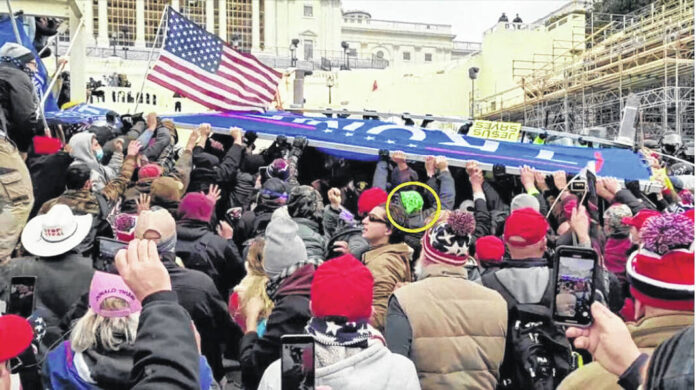TOLEDO — Federal officials arrested a Shawnee Township man Thursday for allegedly shoving a large framed metal “Trump” sign into officers during the Jan. 6, 2021, breach of the U.S. Capitol.
Jonathan Joseph Copeland, 28, of Shawnee Township, faces charges of assaulting, resisting or impeding law enforcement with a dangerous weapon and interfering with a law enforcement officer during a civil disorder, both of which are federal felony charges, according to the U.S. Attorney’s Office of the Northern District of Ohio. He also faces five related misdemeanor charges.
“Copeland was among rioters who illegally entered the Capitol grounds, advancing past barricades,” according to a press release from the U.S. Attorney’s Office. “He failed to stay back despite commands from law enforcement officers. He moved to an area near the scaffolding and joined other rioters in pushing a large, metal sign into a line of law enforcement officers. He shoved the sign into officers attempting to secure the area. He then walked into the Senate Doors and moved through areas including the Crypt and Capitol Visitor Center.”
Copeland made his first court appearance Thursday afternoon at U.S. District Court in Toledo before Magistrate Judge Darrell Clay. He was released on a $10,000 unsecured bond, with conditions including he can’t possess firearms or other deadly weapons. Future cases will be heard in District of Columbia federal courtrooms, including a 1 p.m. Sept. 1 hearing.
Copeland’s criminal record in Allen County is relatively minor, including eight driving-related charges, including one driving under suspension case and four seat-belt violations.
More than 860 people have been arrested in the 19 months since the insurrection at the Capitol, including more than 260 charged with assaulting or impeding law enforcement, according to the Justice Department. Fifty-two are from Ohio, including Donald Chilcoat and Shawndale Chilcoat, of Celina, who were arrested earlier this month.
Recounting of events
Crowds had gathered that day at President Donald Trump’s urging following Trump’s loss in the 2020 presidential election, and the breach delayed the certification of the election.
Copeland was identified as being at the site by two witnesses, one who saw him on footage by CBS News and another who identified him through the FBI’s website.
A statement of facts in the case includes details obtained by the FBI during two interviews with Copeland conducted in February 2021. Both interviews featured similar accounts of Copeland’s actions at the Capitol, the statement said.
According to the FBI, Copeland had traveled to Washington, D.C. with an individual he had met online. After walking early that morning to the area where the election protest rally was set to take place, he and his traveling companion had watched a portion of the speech at the rally before leaving and moving toward the Capitol building.
“They reached the first barricade, a bike rack style barrier manned with [five to seven] police officers,” the statement of facts reads. “Copeland made his way over to the scaffolding on the left side of the crowd area. He also started following a group of people climbing on the scaffolding and crossed on a ramp to the upper level of the U.S. Capitol building.”
The recap of the interview goes on to describe Copeland entering the building through an open door and then joining a crowd of people chanting inside. According to the statement, Copeland said he made his way to the commons area one flight down, going back and forth between the two areas. After going back up to the upper level of the building, he said he encountered smoke and tear gas in a hall filled with statues.
“While inside, Copeland said he received a phone call from the individual with whom he traveled, who said, ‘Son, you know what you’re doing is a crime,’” the statement reads.
Copeland then told the FBI he was able to retrace his path back to his entrance point, where a police officer directed him to exit through a window.
“Copeland told FBI Agents that he felt remorseful, upon leaving the U.S. Capitol, so he deleted his accounts and disposed of his cellphone,” according to the statement of facts.
Other evidence included
The statement of facts filed by the FBI included other steps the bureau took to confirm Copeland’s presence during the incident. While the phone number and email accounts Copeland provided to the bureau did not register on device geolocation data captured from the area during the time in question, law enforcement did find records pertaining to another phone number attributed to Copeland, with that number using cellular towers covering that area, including the interior of the Capitol building, during the incident.
Additionally, a witness who claimed to be the individual who drove Copeland to Washington, D.C. on Jan. 5 was interviewed by the FBI. The witness said he and Copeland were separated at approximately 2 p.m. Jan. 6. The witness attempted to call Copeland several times, according to the statement, before Copeland finally answered and admitted to being in the rotunda of the Capitol building.
Investigators also conducted research on platforms such as Twitter and Facebook, along with U.S. Capitol Police Closed-Circuit Television, finding photo and video evidence of Copeland both outside and inside the Capitol.







